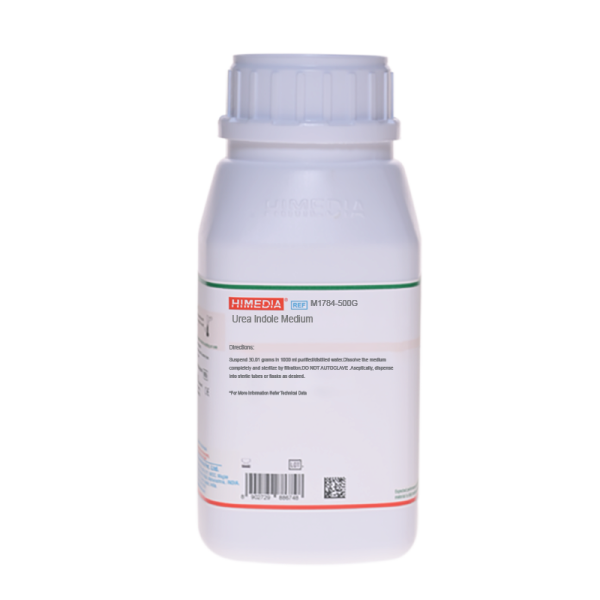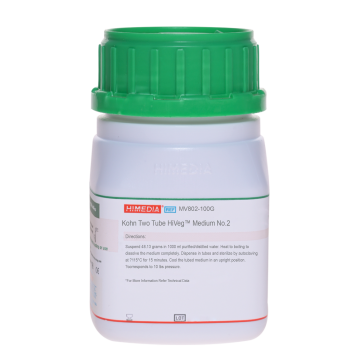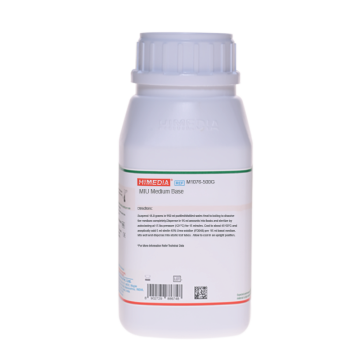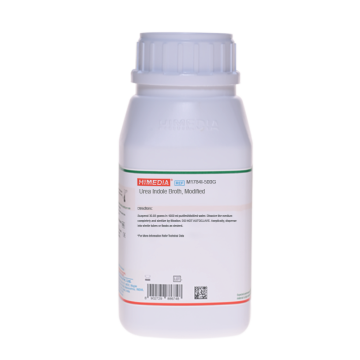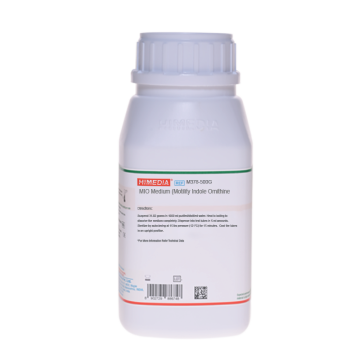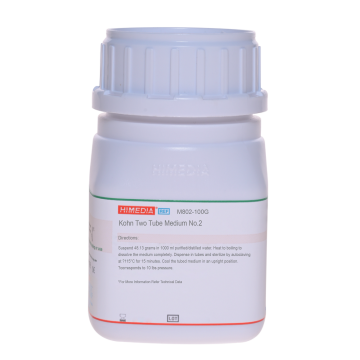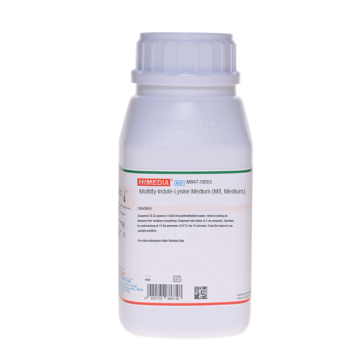 Your enquiry has been submitted
Your enquiry has been submitted
Urea Indole Medium
Intended Use
Recommended for differentiation of micro-organisms especially Enterobacteriaceae on the basis of their ability to hydrolyze urea and indole production.
Composition**
| Ingredients | g / L |
|---|---|
| L- Tryptophan | 3.000 |
| Sodium chloride | 5.000 |
| Potassium dihydrogen phosphate | 1.000 |
| Dipotassium hydrogen phosphate | 1.000 |
| Urea | 20.000 |
| Phenol red | 0.012 |
Final pH ( at 25°C): 6.8±0.2
**Formula adjusted, standardized to suit performance parameters
Directions
Suspend 30.01 grams in 1000 ml purified/distilled water. Dissolve the medium completely and sterilize by filtration. DO NOT AUTOCLAVE. Aseptically, dispense into sterile tubes or flasks as desired.
Principle And Interpretation
Strains of Enterobacteria are associated with abscesses, pneumonia, meningitis, septicemia and infections of wounds, the urinary tract and the intestine. They are a major component of the normal intestinal flora of humans but are relatively uncommon at other body sites. Of clinically significant isolates, Enterobacteriaceae may account for 80% of gram-negative bacilli and 50% of all clinically significant isolates in clinical microbiology laboratories (1).
Urea Indole Medium is used for the identification of Enterobacteria on the basis of Urease and indole production and the transdeamination of tryptophan. This medium is very useful in the identification of Proteus species from Salmonella and Shigella species. The results for urease production should be noted prior to indole reaction, as addition of Kovac's reagent, decolourizes the medium, due to drop in pH.
L-Tryptophan is an essential amino acid and is converted to skatole and indole, which is detected by the addition of Kovac's Reagent (R008). Sodium chloride maintains the osmotic balance. The phosphates helps in the buffering of the medium. Microorganisms that possess the enzyme urease hydrolyse urea, releasing ammonia, which is detected by the pH indicator phenol red. The alkalinity so developed imparts pink colour to the medium (2).
Type of specimen
Isolated Microorganisms from clinical samples
Specimen Collection and Handling
For clinical samples follow appropriate techniques for handling specimens as per established guidelines (3,4). After use, contaminated materials must be sterilized by autoclaving before discarding.
Warning and Precautions
In Vitro diagnostic Use only. For professional use only. Read the label before opening the container. Wear protective gloves/protective clothing/eye protection/face protection. Follow good microbiological lab practices while handling specimens and culture. Standard precautions as per established guidelines should be followed while handling clinical specimens. Safety guidelines may be referred in individual safety data sheets.
Limitations
- All urea test media rely on the alkalinity formation and so they are not specific for determining the absolute rate of urease activity.
- Further biochemical and serological tests must be carried out for complete identification.
Performance and Evaluation
Performance of the medium is expected when used as per the direction on the label within the expiry period when stored at recommended temperature.
Quality Control
Appearance: Light yellow to light pink homogeneous free flowing powder
Colour and Clarity of prepared medium: Yellow to light orange coloured clear solution
Reaction: Reaction of 3.00% w/v aqueous solution at 25°C. pH : 6.8±0.2
pH: 6.60-7.00
Cultural Response
Cultural characteristics observed after an incubation at 35-37°C for 18-24 hours.
| Organism | Growth | Urease |
|---|---|---|
| Escherichia coli ATCC 25922 (00013*) | luxuriant | Negative reaction,no change |
| Proteus mirabilis ATCC 12453 | luxuriant | Positive reaction, Pink colour |
| ## Proteus hauseri ATCC 13315 | luxuriant | Positive reaction, Pink colour |
| Salmonella Typhimurium ATCC 14028 (00031*) | luxuriant | Negative reaction,no change |
Key : (*) Corresponding WDCM numbers. ## Formerly known as Proteus vulgaris
Storage and Shelf Life
Store between dehydrated and the prepared medium at 2-8°C. Use before expiry date on the label. On opening, product should be properly stored dry, after tightly capping the bottle in order to prevent lump formation due to the hygroscopic nature of the product. Improper storage of the product may lead to lump formation. Store in dry ventilated area protected from extremes of temperature and sources of ignition. Seal the container tightly after use. Product performance is best if used within stated expiry period.
Disposal
User must ensure safe disposal by autoclaving and/or incineration of used or unusable preparations of this product. Follow established laboratory procedures in disposing of infectious materials and material that comes into contact with clinical sample must be decontaminated and disposed of in accordance with current laboratory techniques (3,4).
Reference
- Patrick R. Murray et al, Manual of Clinical Microbiology, Sixth Edition, 444 - 445.
- Roland F. Bourbon D, Sztrum S. Ann. Inst. Pasteur, 73. 914-916.
- Isenberg, H.D. Clinical Microbiology Procedures Handbook 2nd Edition.
- Jorgensen, J.H., Pfaller, M.A., Carroll, K.C., Funke, G., Landry, M.L., Richter, S.S and Warnock., D.W. (2015) Manual of Clinical Microbiology, 11th Edition. Vol. 1.
| Product Name | Urea Indole Medium |
|---|---|
| SKU | M1784 |
| Product Type | Regular |
| Physical Form | Powder |
| Origin | Chemically defined |
| Packaging type | HDPE |
| References | 1.Patrick R. Murray et al, Manual of Clinical Microbiology, Sixth Edition, 444 - 445.2.Roland F. Bourbon D, Sztrum S. Ann. Inst. Pasteur, 7 |
| Customized Product Available | No |



